
Hiking Around Las Vegas, Gold Butte National Monument

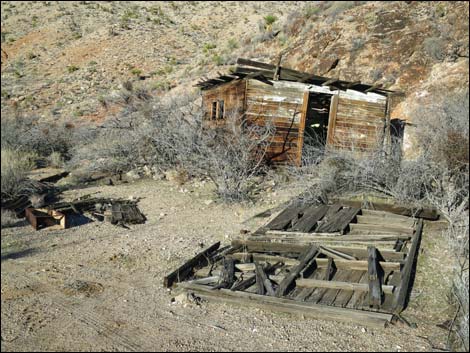 Azure Miner's cabin and debris (view N) Azure Miner's cabin and debris (view N) |
Overview Azure Cabin and Azure Mine (aka Azure Ridge Mine) are historic sites that harken back to the heyday of copper mining in the Gold Butte region during about 1890-1918. Plywood on the cabin walls probably post-dates 1928, so the standing cabin may have been built or retrofitted in the 1950s during resurgent, but failed, copper mining activity in this area. The mine includes three opening: two adits and a shaft. The walls of the shaft collapsed, but the wooden framework remains. The two adits are not safe to enter, evidenced by the wooden frame on the lower adit falling apart and roof collapse in the upper adit. Starting from the cabin at the end of Garden Wash Road, hikers can walk down into the canyon for about 1/4 miles to Azure Mine. Beyond the mine, the route continues down the narrowing wash. At the narrowest point there are interesting fossils in the rock walls. Link to map. |
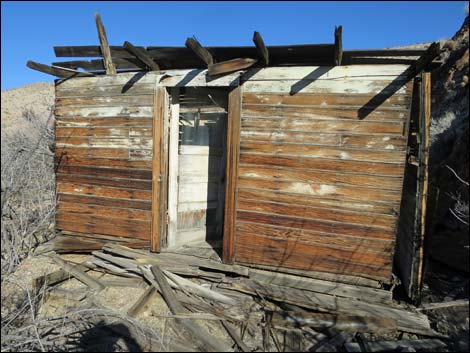 Azure Miner's cabin exterior and debris (view N) Azure Miner's cabin exterior and debris (view N) |
Watch Out Other than the standard warnings about hiking in the desert, ... this is a safe area and a safe hike if hikers don't enter the mine openings. It is never safe to enter holes in the ground. Don't step on rusty nails around the cabin. This is a wild and remote area without services of any kind (no restrooms, no water, no gas, no food). Bring what you need to survive. Be prepared and be self-reliant. Someone will find you eventually if you stay on a main road, but be prepared to survive alone for a day or two. Cell phones don't work in this area. While hiking, please respect the land and the other people out there, and try to Leave No Trace of your passage. Also, this is a remote hike, so be sure to bring the 10 Essentials. |
 Azure Miner's cabin interior (view NW) |
Getting to the Trailhead Azure Cabin and Azure Mine are located out in Gold Butte National Monument at the northeast end of Lake Mead, about 4 hours northeast of Las Vegas in a wild, remote, and scenic area adjacent to the Arizona Border. From town, drive out to Gold Butte National Monument. From Whitney Pocket, continue south on the unpaved Gold Butte Road for 16.2 miles to a fork in the road. Stay left onto Devils Cove Road and drive southeast for an additional 1.0 miles to Garden Spring Road, a sandy road in the wash on the left. Following Garden Spring Road 0.7 miles to Garden Spring and Corral, Garden Wash Road forks left in front of the corral. Driving 4 miles northeast on Garden Wash Road, the road ends near the mouth of the narrow Garden Canyon and 20 yards before the historic Azure Cabin. About 20 yards before the road ends, there is a convenient place to turn around and stop. Park here; this is the trailhead. |
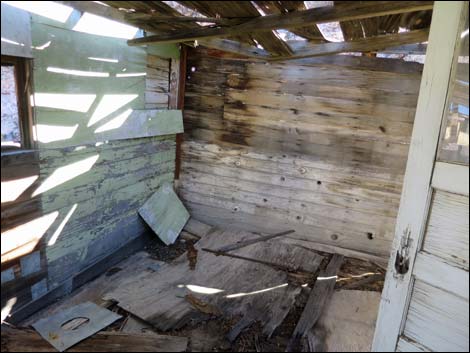 Azure Miner's cabin interior (view NE) |
The Hike From the trailhead (Table 1, Waypoint 01), the route runs some 20 yards to the old Azure Cabin (Wpt. 02). Little is left except for the shell of one cabin and the collapsed boards of another. Nothing of particular interest remains, but it is interesting to consider the lives of men who lived and worked here in the 1890-1918 time frame. The plywood on the walls probably post-dates 1928, so the standing cabin may have been built or retrofitted in the 1950s during resurgent copper mining activity in this area. From the cabin, the route runs down the wash into the canyon. Before long, the canyon walls narrow (Wpt. 03) and the hike gets more interesting. For details of the hike, see Garden Canyon Hike. After winding around a few bends, hikers arrive at Azure Mine (Wpt. 04), on the right. This mine was active from about 1890 to 1918 and provided copper and zinc with smaller amounts of gold, silver, and other minerals. |
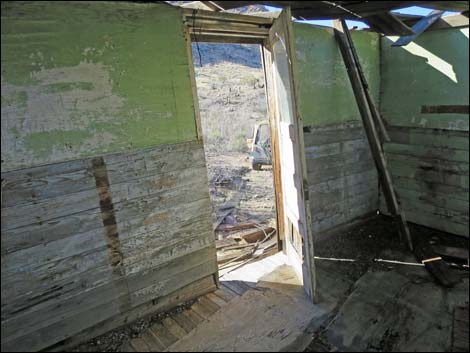 Azure Miner's cabin interior (view SW) |
In the mine area, the north side of the wash appears to have been used as a work or staging area. The mine openings are on the south side of the wash. The lower mine opening is just above wash level and had been shorn up with timbers, but they are falling apart after so many years. There is a bundle of timbers at the entrance, and this adit goes into hard rock and is relatively safe, but holes in the ground are never safe to enter, and certainly the timbers at the entrance are falling away, so don't touch anything that could encourage the mountain side to collapse. Just up and left (east) from the lower adit, there is a work area, and higher up the slope, there are two additional adits atop the tailings pile. The middle adit is directly above the work area, and the third adit is up and right from there. At the work area, there is a pile of dark-colored ore, some pipes, and the remains of a wooden table or loading ramp. This area was dug out, so it is possible that it was worked as a surface-mine. |
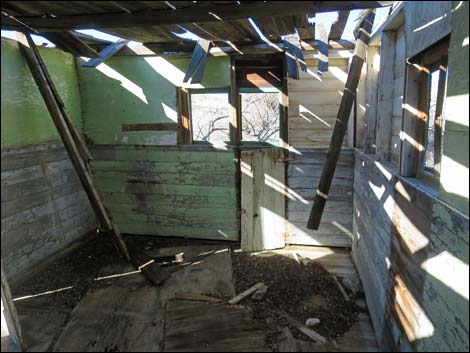 Azure Miner's cabin interior (view W) |
From the left (east) side of the work area, a miner's trail climbs steeply adjacent to the tailings pile. The start of the trail is hard to see because it climbs over limestone rock. Above there, short, tight switchbacks and wooden stairs lead to a level landing atop the tailings pile and the middle adit, which has no timbers to shore up the entrance. This one goes back to a cave-in (evidence that it is not safe). Up and right (west) from the middle adit, there is another surface-mine area where miners just removed hillside materials, and just beyond there, the third opening is a vertical shaft with timbers and head-gear, but the walls of the shaft have caved in and it is closed. Back in the wash, hikers might want to continue down the canyon, which is long, deep, and becomes quite arrow. For details, see Garden Canyon Hike. |
Azure Miner's Cabin
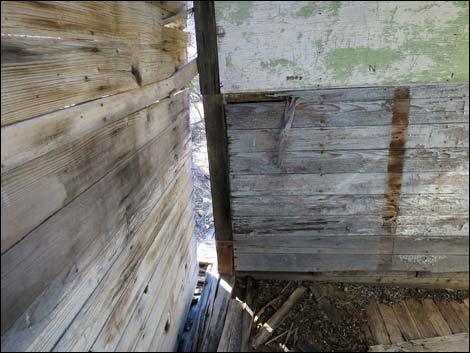 Azure Miner's cabin interior (view S) |
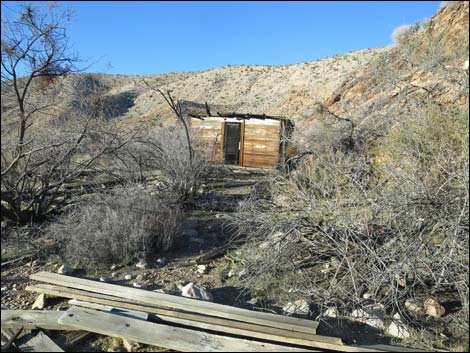 Debris by the miner's cabin (view NW) |
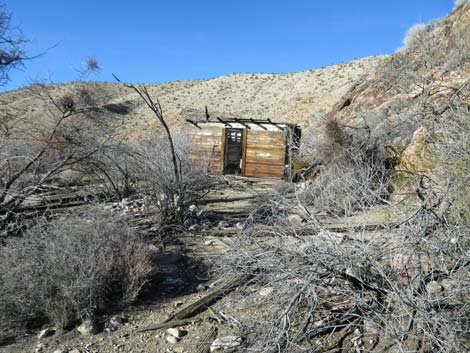 Azure Miner's cabin and debris (view N) |
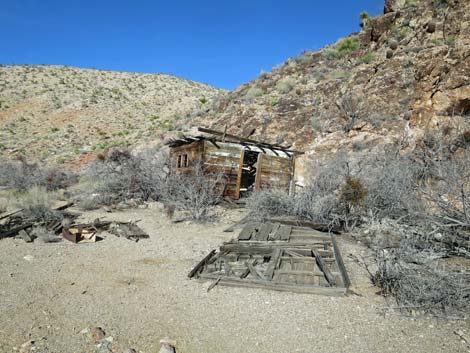 Azure Miner's cabin and debris (view N) |
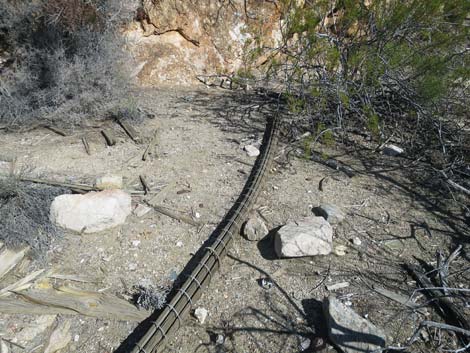 Wooden pipe |
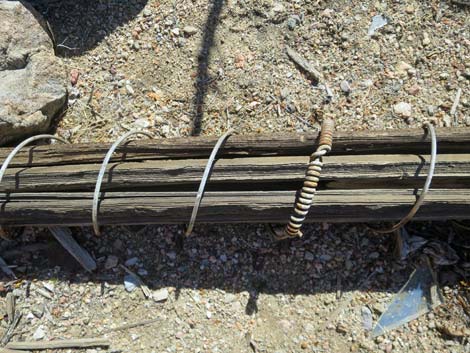 Wooden pipe |
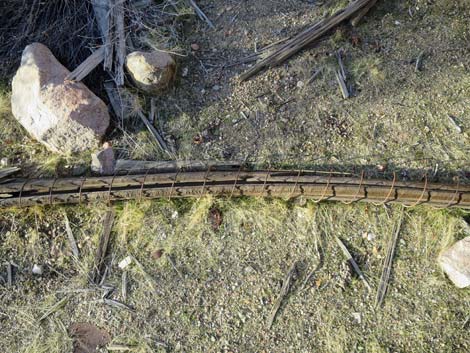 Wooden pipe |
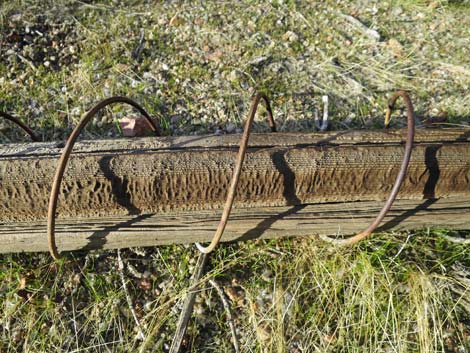 Wooden pipe |
 Wooden pipe |
 Debris by the miner's cabin (view NW) |
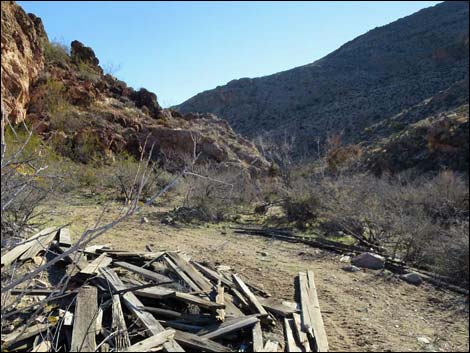 Debris by the miner's cabin and route to the mine (view E) |
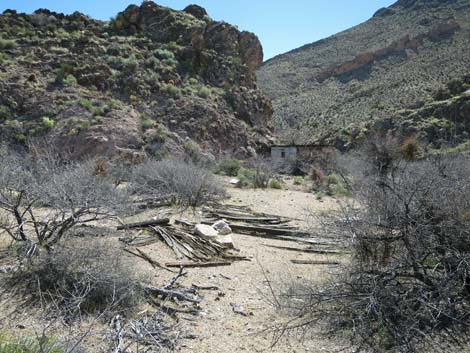 Debris behind the miner's cabin (view SE) |
Conditions in January 2020 -- The roof is collapsing
 |
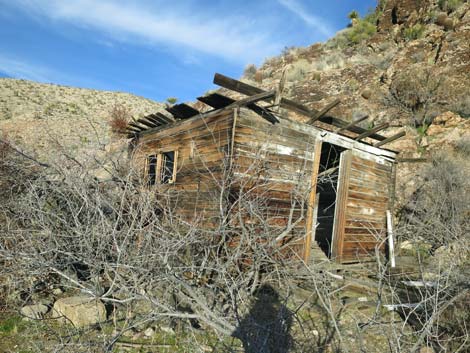 |
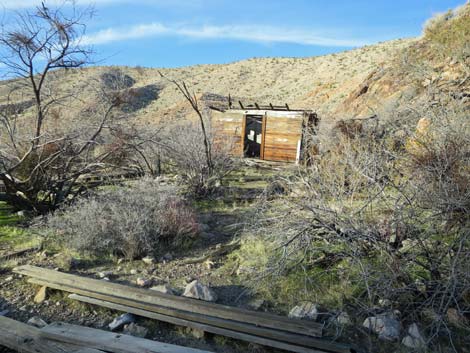 |
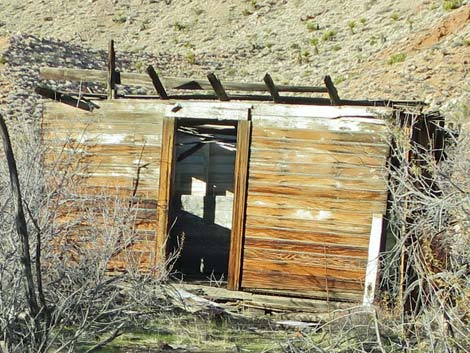 |
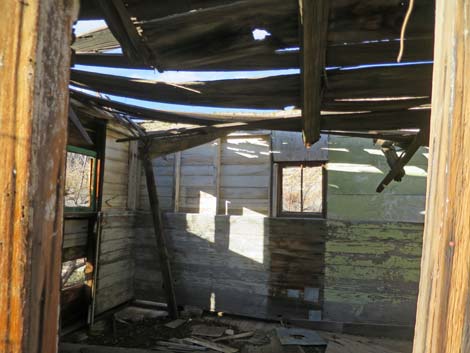 |
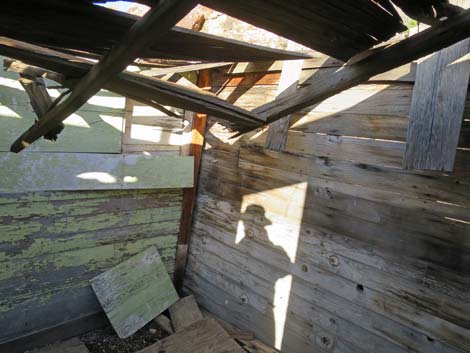 |
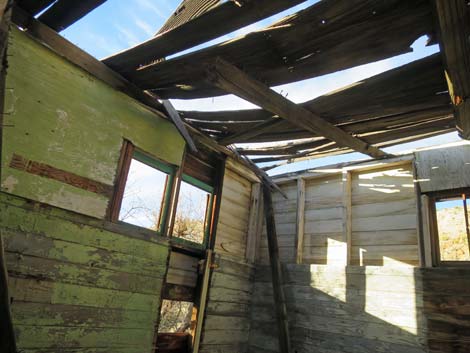 |
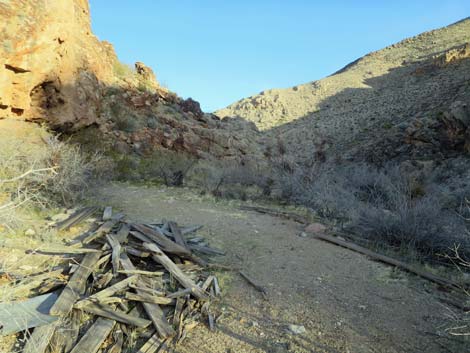 |
 |
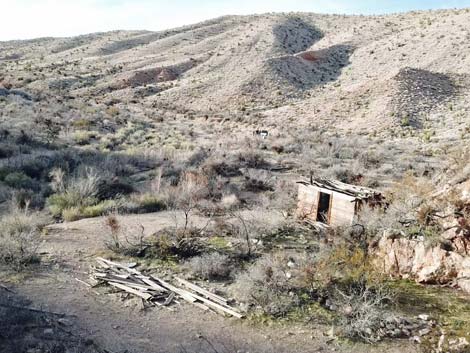 |
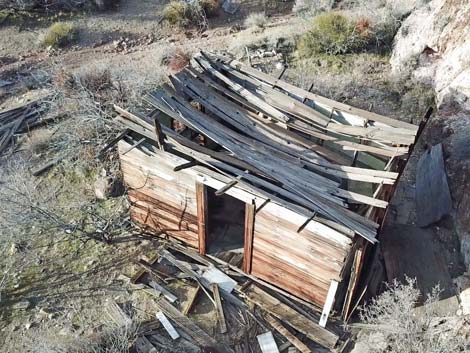 |
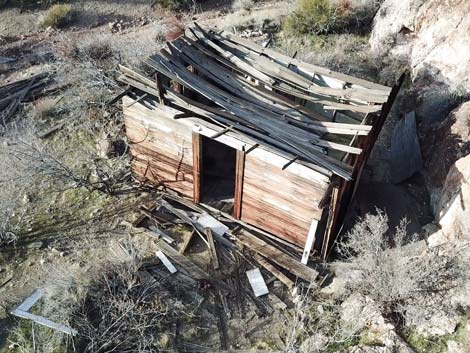 |
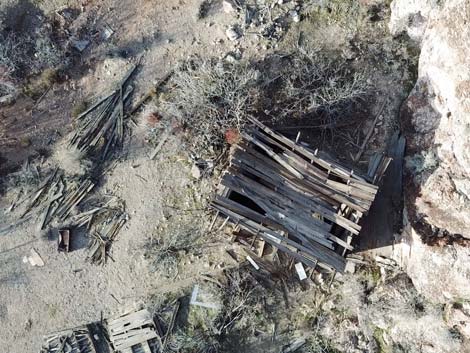 |
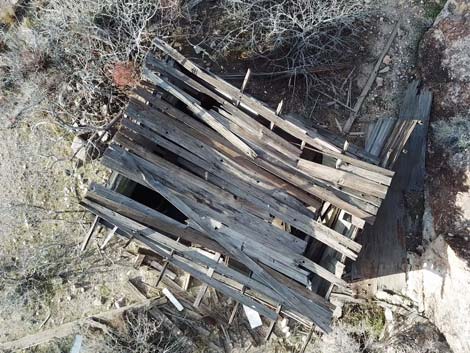 |
Azure Mine
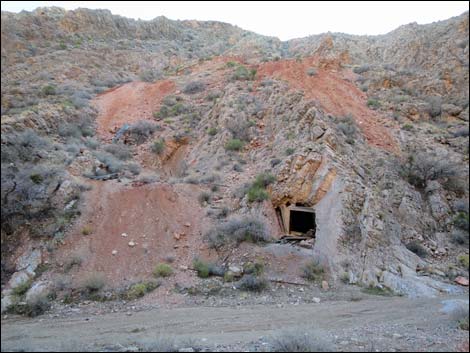 Azure Mine, lower adit (view S) |
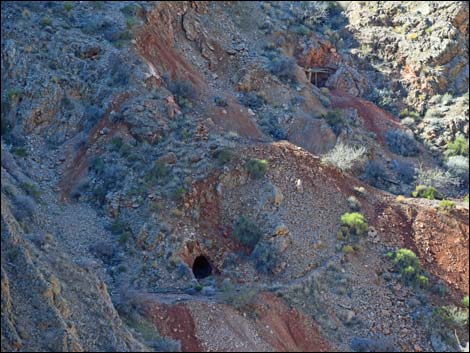 Azure Mine, upper two entrances (view SW from across canyon) |
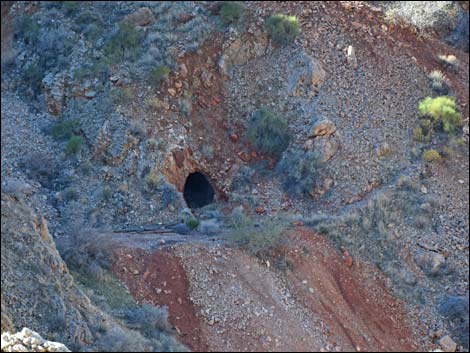 Middle adit (view SW from across canyon) |
 Upper shaft with timbers (view SW from across canyon) |
Lower Adit
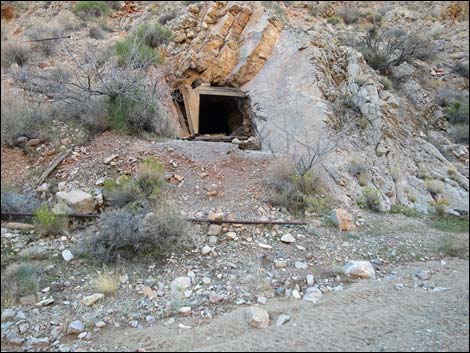 |
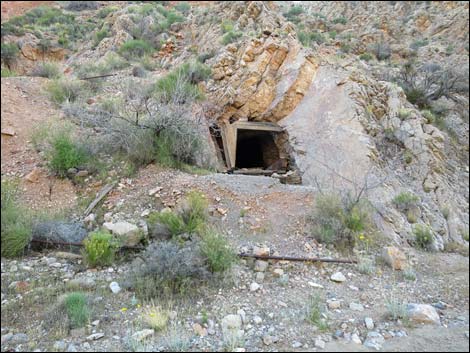 |
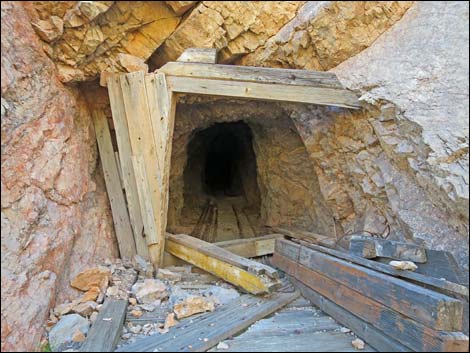 |
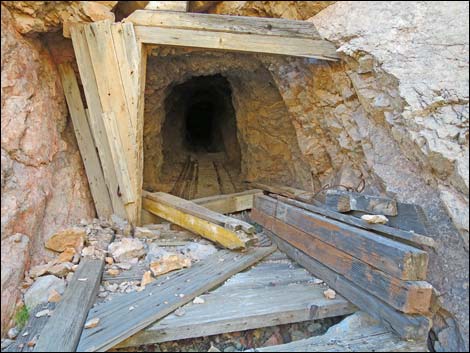 |
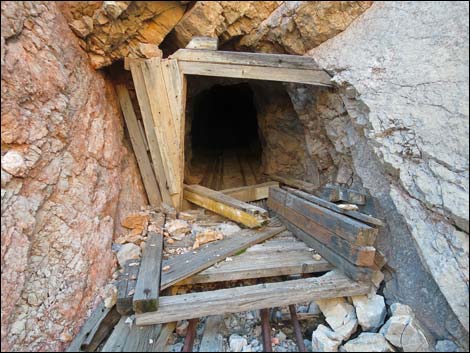 |
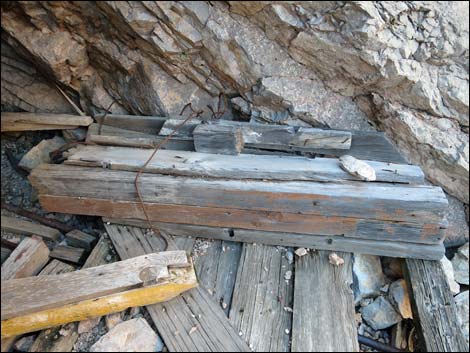 |
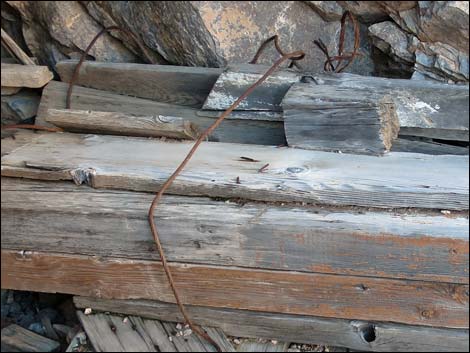 |
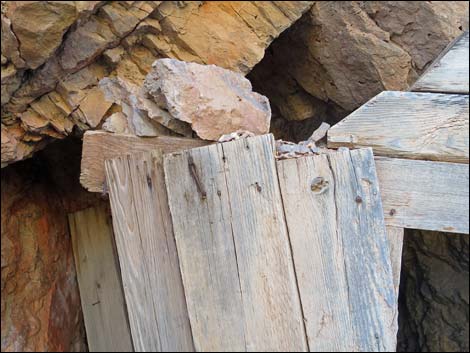 |
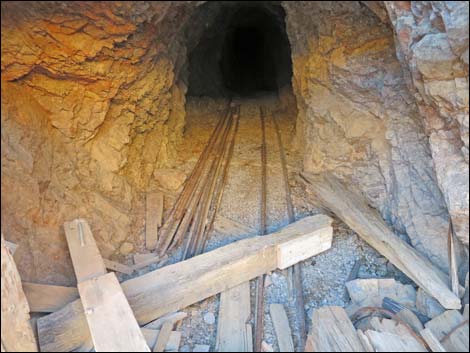 Fallen timbers at the entrance |
 Rock Wren poop built up over the decades |
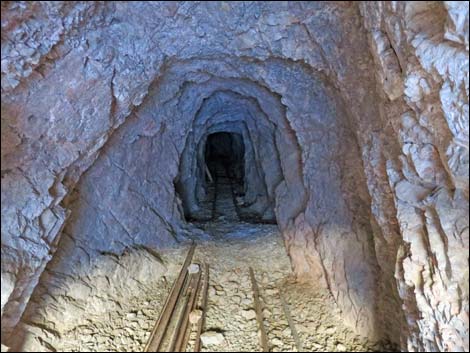 Approaching a small roof collapse (note debris on the floor) |
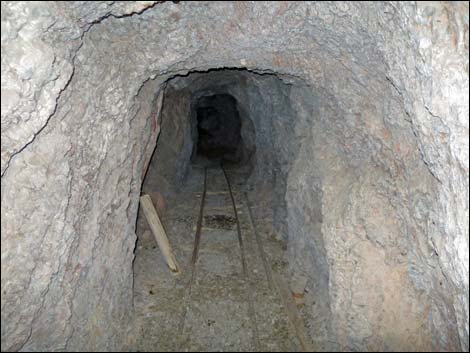 Ore car tracks and an air pipe leading into the darkness |
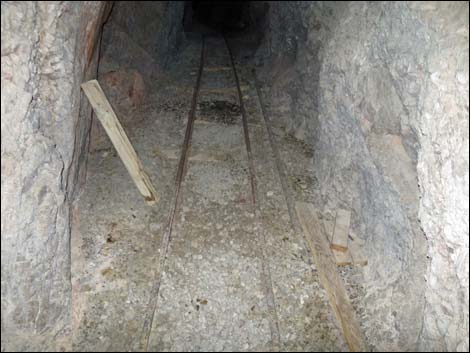 Odd place for a piece of wood |
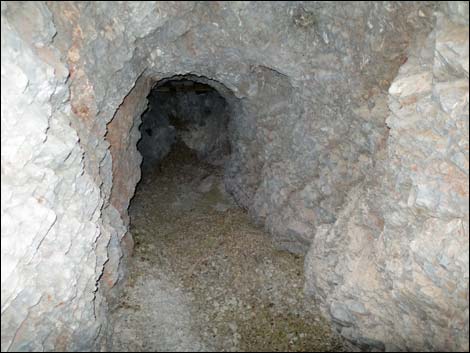 Approaching end of tunnel (note vegetation brought by packrats) |
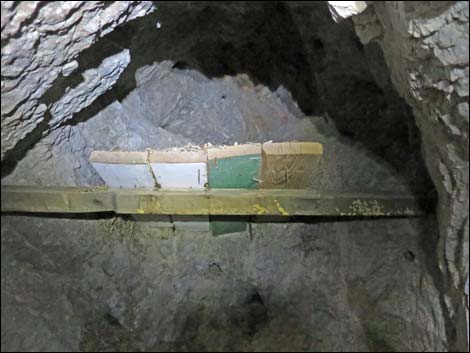 Shelf built to work upward |
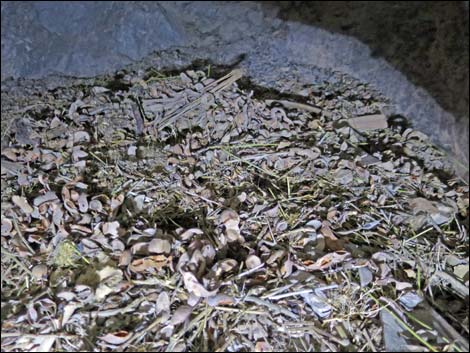 Packrat midden atop the shelf |
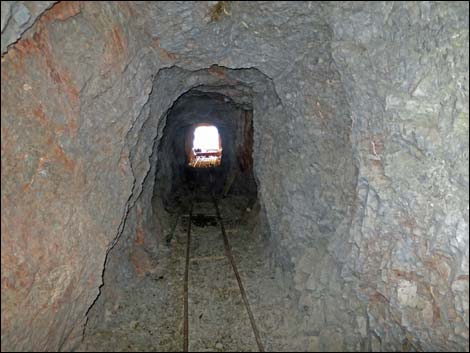 Returning out of the tunnel |
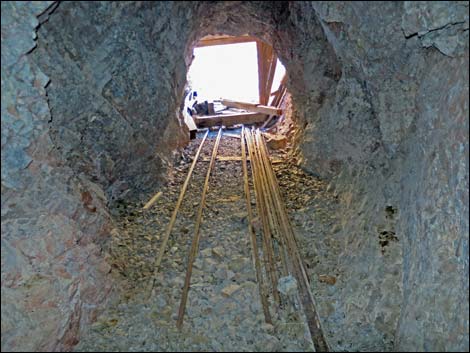 Returning out of the tunnel |
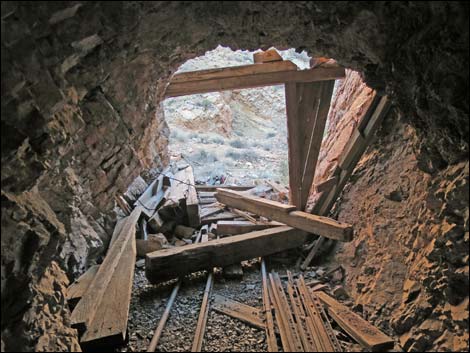 Jumble of fallen timbers at mouth of the tunnel |
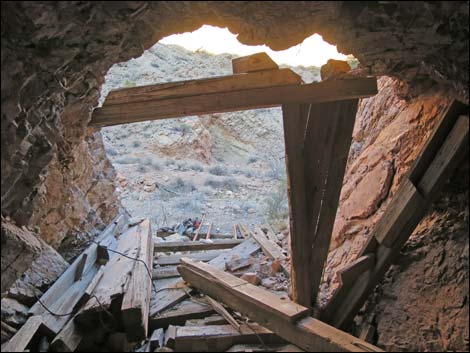 That isn't safe! |
Work Area and Tailings Pile
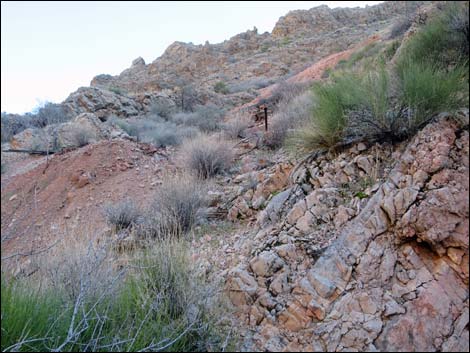 Trail leading up from lower adit (view SE) |
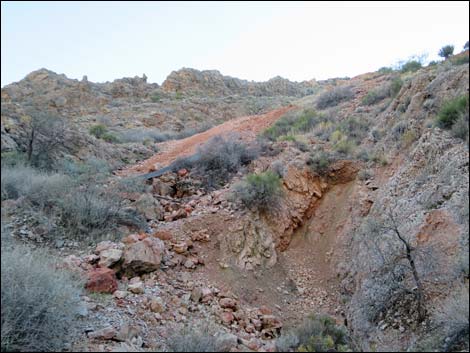 Open-pit mine area |
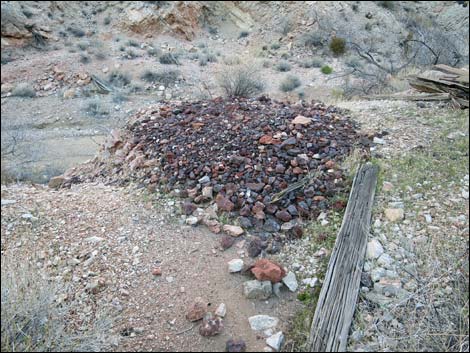 Ore dumped on the ground |
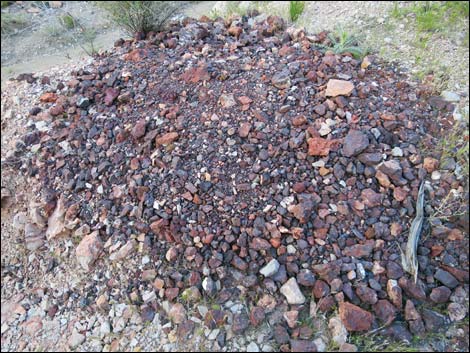 Ore pile |
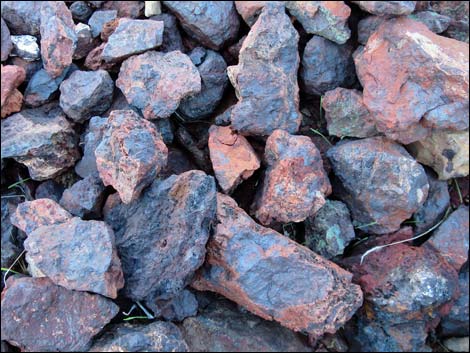 Colorful ore |
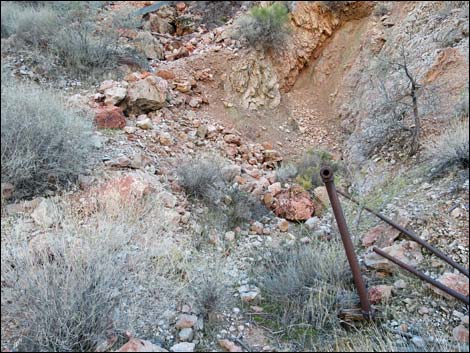 Old pipes |
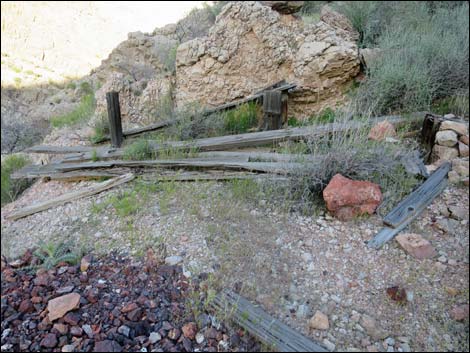 Remains of table or loading ramp |
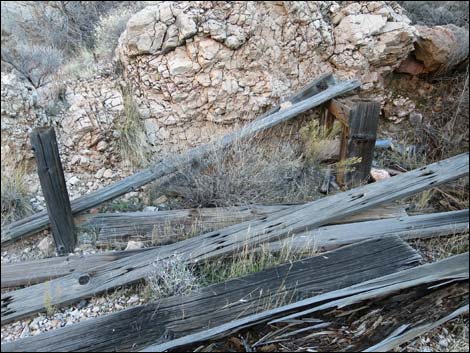 Remains of table or loading ramp |
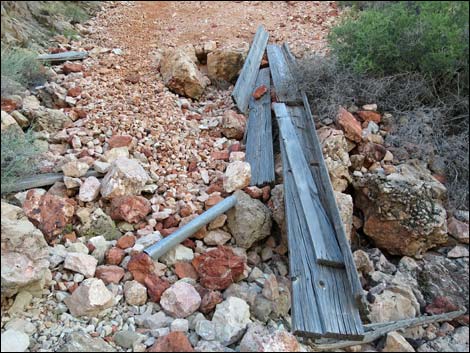 Wood and pipes fallen from atop tailings pile |
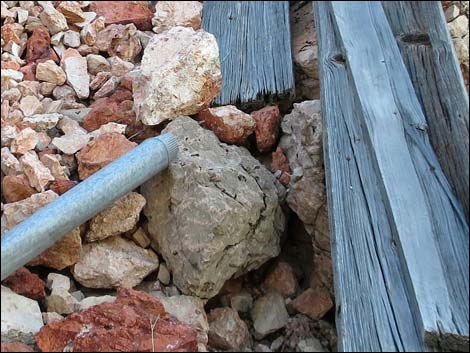 Wood and pipes |
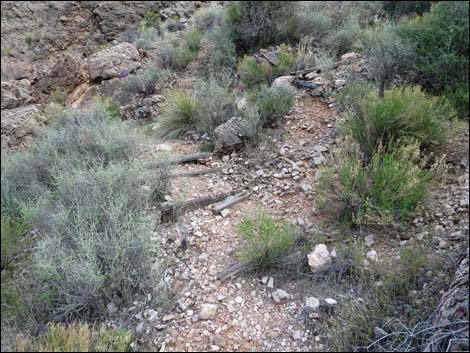 Wooden stairs on miner's trail |
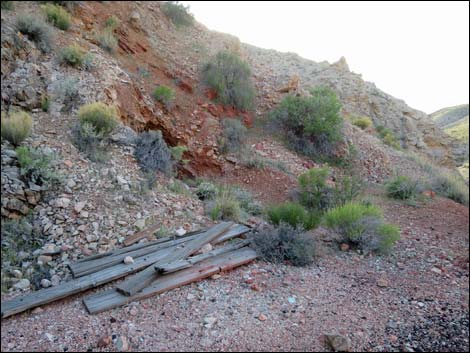 Landing atop tailings pile; approaching middle adit (view SW) |
Middle Adit
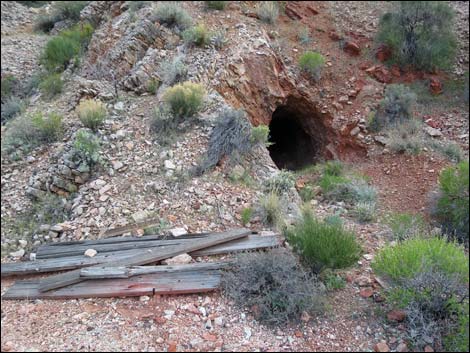 Middle adit without shoring timbers |
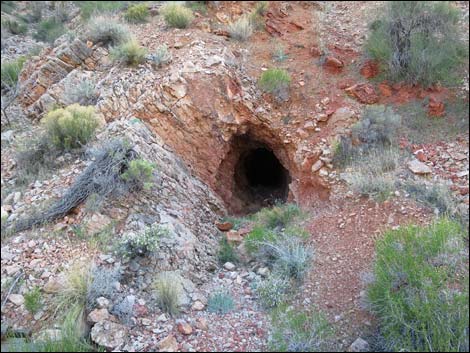 Middle adit without shoring timbers |
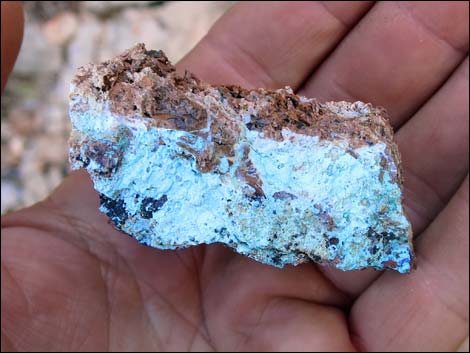 A piece of copper ore outside the adit |
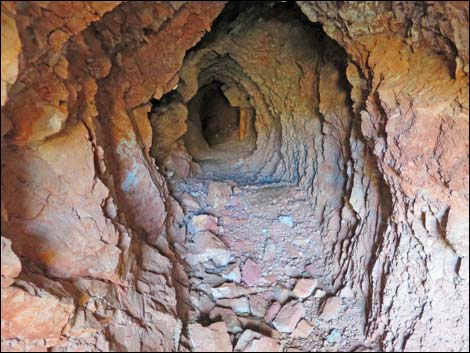 Mouth of middle adit; note rock debris on the floor |
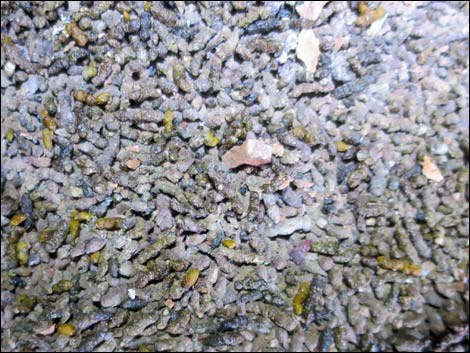 Bat guano |
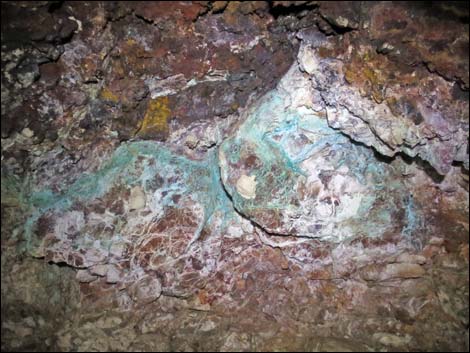 Vein of copper ore in the upper wall of the tunnel |
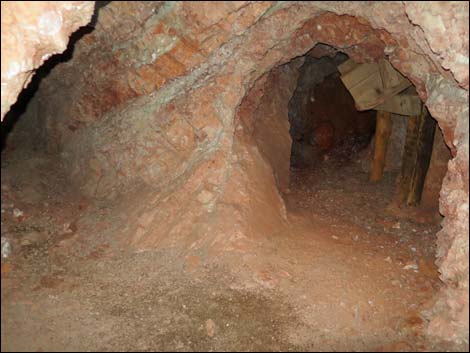 Tunnel forks; left dead ends quickly |
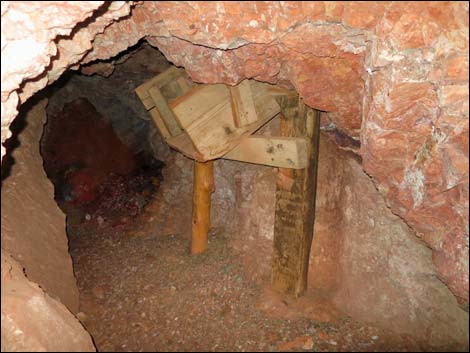 Wooden ore chute |
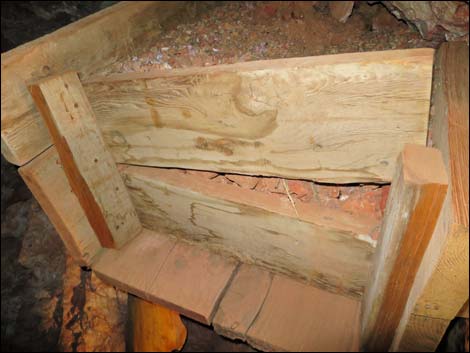 Wooden ore chute (end view) |
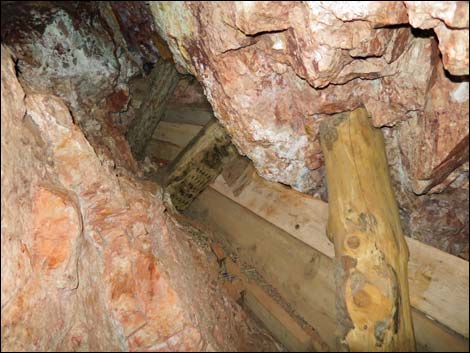 Wooden ore chute coming down from above (side view) |
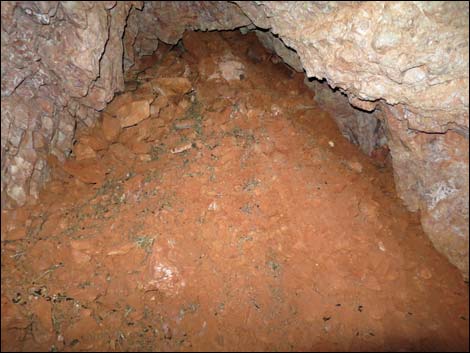 Collapsed side tunnel |
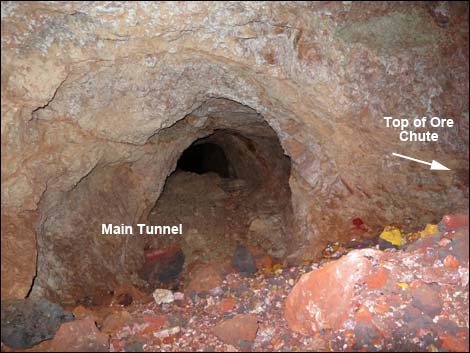 Main tunnel is partially collapsed |
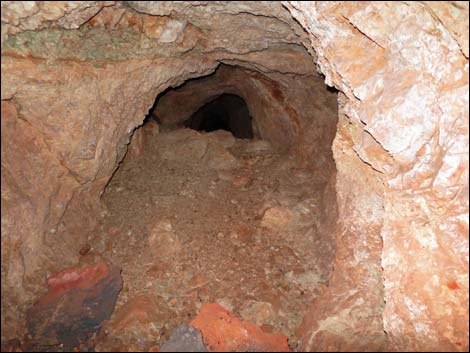 Main tunnel is partially collapsed |
 Top of ore chute in short side tunnel |
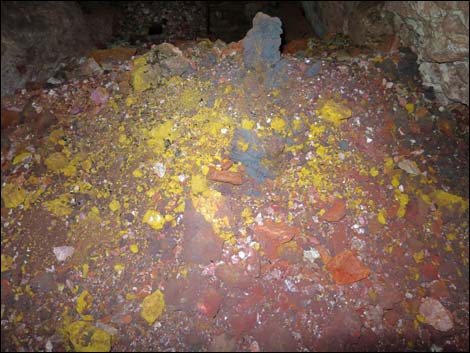 Colorful ore on the floor, ready to shovel into chute |
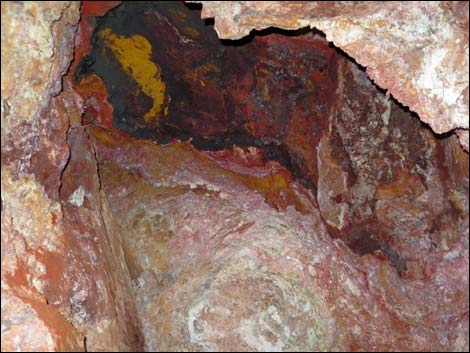 Top of the cavern above ore chute |
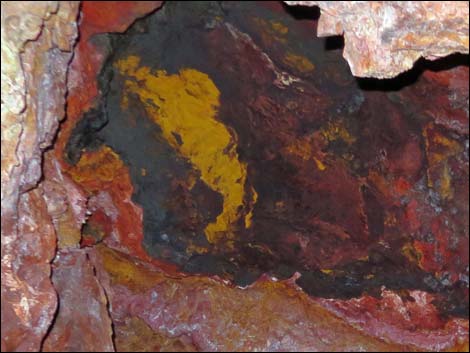 Top of the cavern above ore chute (zoom) |
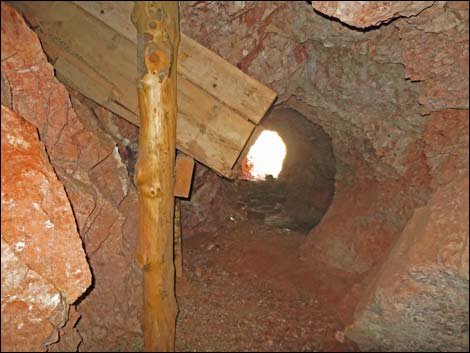 Exiting the tunnel |
Upper Shaft
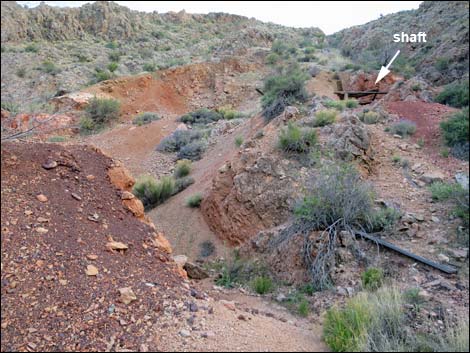 Surface-mine area and upper mine entrance |
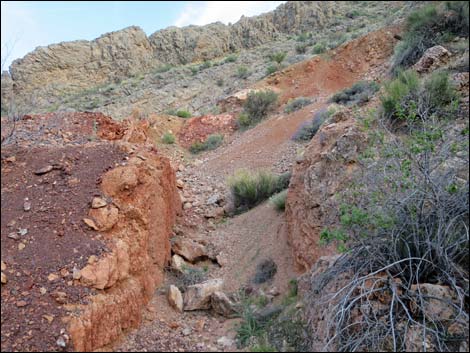 Surface-mine area |
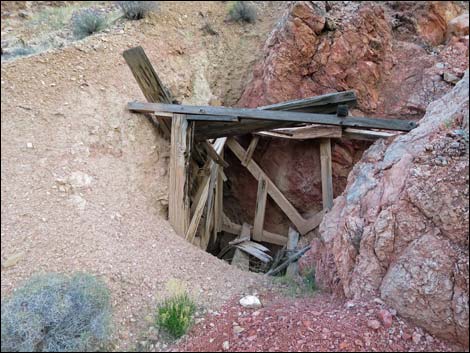 Upper mine opening |
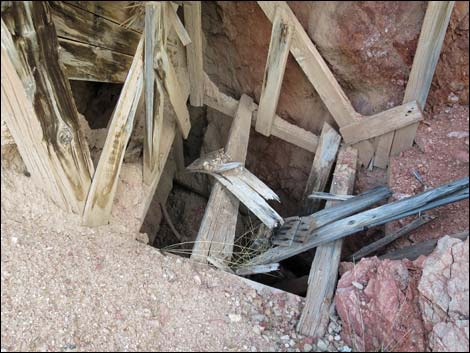 Wooden timbers couldn't prevent the walls collapsing |
 Damaged wooden timbers |
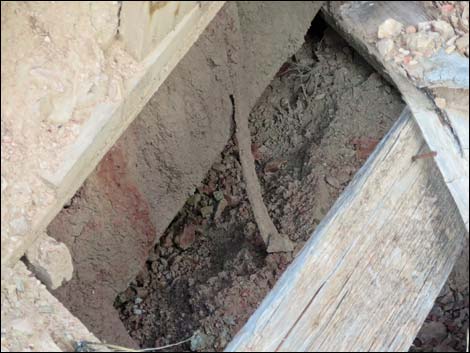 Just below the timbers, dirt fills the bottom of the shaft |
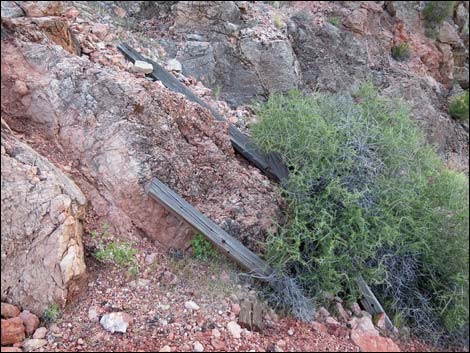 Wood scattered near the shaft |
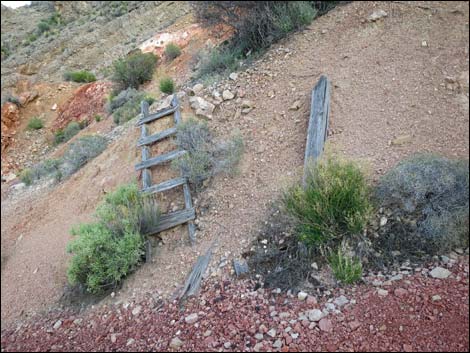 A ladder and wood scattered near the shaft |
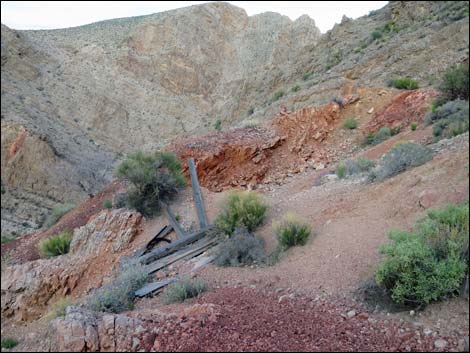 Wood scattered near the shaft |
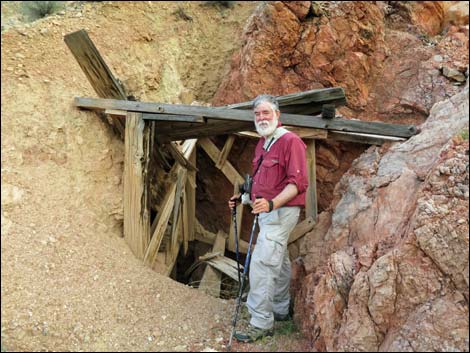 Remember -- it is never safe to enter holes in the ground! |
Descending along the Tailings Pile
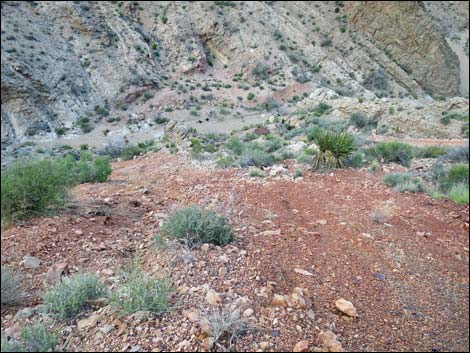 Top of the tailings pile -- it is a long way to the wash |
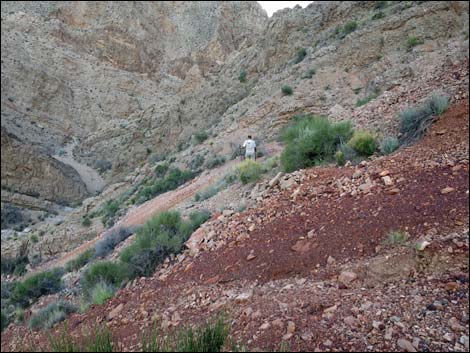 Hiker descending from the landing |
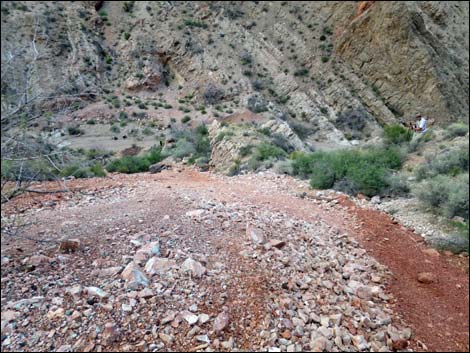 Hiker descending steep terrain along side the tailings pile |
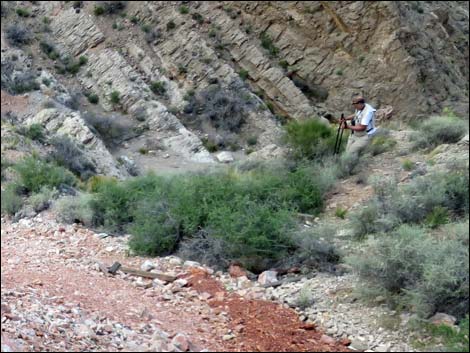 Hiker descending steep miner's trail |
Table 1. Hiking Coordinates Based on GPS Data (NAD27, UTM Zone 11S). Download Hiking GPS Waypoints (*.gpx) file.
| Site | Location | UTM Easting | UTM Northing | Latitude (N) | Longitude (W) | Elevation (ft) |
|---|---|---|---|---|---|---|
| 01 | Trailhead | 761569 | 4023129 | 2,821 | 0.00 | 0.00 |
| 02 | Azure Cabin | 761592 | 4023127 | 2,820 | 0.01 | 0.01 |
| 03 | Top - Upper Canyon | 761767 | 4023087 | 2,792 | 0.12 | 0.13 |
| 04 | Azure Mine | 761927 | 4023111 | 2,772 | 0.15 | 0.28 |
| 01 | Trailhead | 761569 | 4023129 | 2,821 | 0.00 | 0.56 |
Happy Hiking! All distances, elevations, and other facts are approximate.
![]() ; Last updated 240325
; Last updated 240325
| Hiking Around Gold Butte | Hiking Around Las Vegas | Glossary | Copyright, Conditions, Disclaimer | Home |